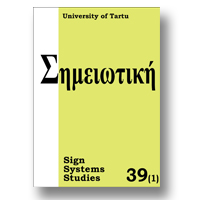|
|
|
61.
|
Sign Systems Studies:
Volume >
37 >
Issue: 1/2
Andres Luure
Tegevus märkides. Kokkuvõte
view |
rights & permissions
| cited by
|
|
|
|
|
|
|
62.
|
Sign Systems Studies:
Volume >
37 >
Issue: 1/2
Andres Luure
Деятельность в знаках. Резюме
view |
rights & permissions
| cited by
|
|
|
|
|
|
|
63.
|
Sign Systems Studies:
Volume >
37 >
Issue: 1/2
Prisca Augustyn
Translating Jakob von Uexküll — Reframing Umweltlehre as biosemiotics
abstract |
view |
rights & permissions
| cited by
Thomas Sebeok attributed it to what he called the ‘wretched’ translation of Uexküll’s Theoretische Biologie (1920) that the notion of Umwelt did not reachthe Anglo-American intellectual community much earlier. There is no doubt that making more of Uexküll’s Umweltlehre available in English will not only furtherthe biosemiotic movement, but also fill a gap in the foundational theoretical canon of semiotics in general. The purpose of this paper is to address issues of terminology and theory translation between Uexküll’s Umweltlehre and current biosemiotics.
|
|
|
|
|
|
|
64.
|
Sign Systems Studies:
Volume >
37 >
Issue: 1/2
Prisca Augustyn
Как переводить Якоба фон Юкскюлла:
включение Umweltlehre в рамки биосемиотики. Резюме
view |
rights & permissions
| cited by
|
|
|
|
|
|
|
65.
|
Sign Systems Studies:
Volume >
37 >
Issue: 1/2
Prisca Augustyn
Jakob von Uexkülli tõlkimisest — Umweltlehre toomine biosemiootikasse. Kokkuvõte
view |
rights & permissions
| cited by
|
|
|
|
|
|
|
66.
|
Sign Systems Studies:
Volume >
37 >
Issue: 1/2
Karel Kleisner, Anton Markoš
Mutual understanding and misunderstanding in biological systems mediated by self-representational meaning of organisms
abstract |
view |
rights & permissions
| cited by
Modern biology gives many casuistic descriptions of mutual informational interconnections between organisms. Semiotic and hermeneutic processes in biosphere require a set of “sentient” community of players who optimize their living strategies to be able to stay in game. Perceptible surfaces of the animals, semantic organs, represent a special communicative interface that serves as an organ of self-representation of organic inwardness. This means that theinnermost dimensions and potentialities of an organism may enter the senses of other living being when effectively expressed on the outermost surfaces of theformer and meaningfully interpreted by the later. Moreover, semantic organs do not exist as objectively describable entities. They are always born via interpretative act and their actual form depends on both the potentialities of body plan of a bearer and the species-specific interpretation of a receiver. As such the semantic organs represent an important part of biological reality and thus deserve to be contextualized within existing comparative vocabulary. Here we argue that the study of the organic self-representation has a key importance for deeper insight into the evolution of communicative coupling among living beings.
|
|
|
|
|
|
|
67.
|
Sign Systems Studies:
Volume >
37 >
Issue: 1/2
Karel Kleisner, Anton Markoš
Взаимное (не)понимание в биологических системах на основе саморепрезентации организмов. Резюме
view |
rights & permissions
| cited by
|
|
|
|
|
|
|
68.
|
Sign Systems Studies:
Volume >
37 >
Issue: 1/2
Karel Kleisner, Anton Markoš
Vastastikune mõistmine ja vääritimõistmine bioloogilistes susteemides organismide enese-esituslike tähenduste vahendusel
view |
rights & permissions
| cited by
|
|
|
|
|
|
|
69.
|
Sign Systems Studies:
Volume >
37 >
Issue: 1/2
Howard H. Pattee, Kalevi Kull
A biosemiotic conversation:
Between physics and semiotics
abstract |
view |
rights & permissions
| cited by
In this dialogue, we discuss the contrast between inexorable physical laws and the semiotic freedom of life. We agree that material and symbolic structures require complementary descriptions, as do the many hierarchical levels of their organizations. We try to clarify our concepts of laws, constraints, rules, symbols, memory, interpreters, and semiotic control. We briefly describe our different personal backgrounds that led us to a biosemiotic approach, and we speculate on the future directions of biosemiotics.
|
|
|
|
|
|
|
70.
|
Sign Systems Studies:
Volume >
37 >
Issue: 1/2
Howard H. Pattee, Kalevi Kull
Biosemiootiline vestlus:
füüsika ja semiootika vahel. Kokkuvõte
view |
rights & permissions
| cited by
|
|
|
|
|
|
|
71.
|
Sign Systems Studies:
Volume >
37 >
Issue: 1/2
Howard H. Pattee, Kalevi Kull
Биосемиотическая беседа:
между физикой и семиотикой. Резюме
view |
rights & permissions
| cited by
|
|
|
|
|
|
|
72.
|
Sign Systems Studies:
Volume >
37 >
Issue: 1/2
Sergey V. Chebanov, Anton Markoš
A text on biosemiotic themes
view |
rights & permissions
| cited by
|
|
|
|
